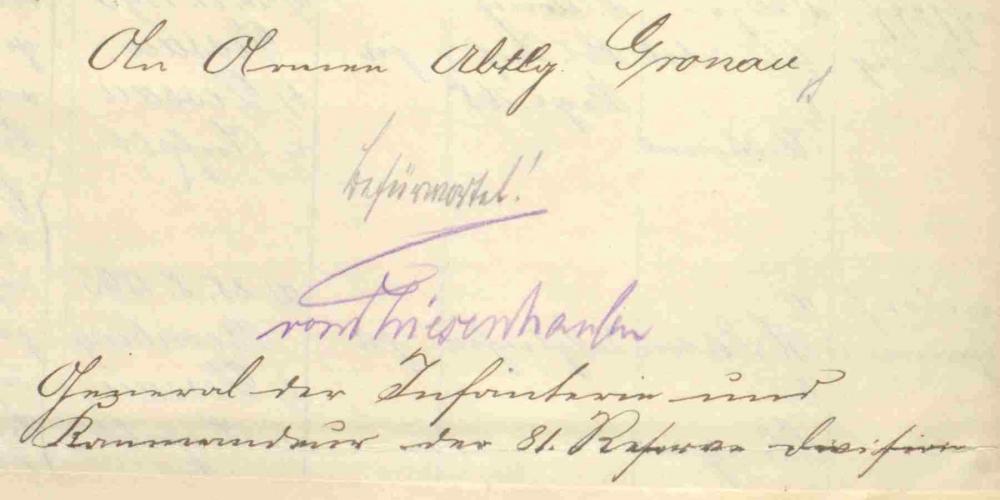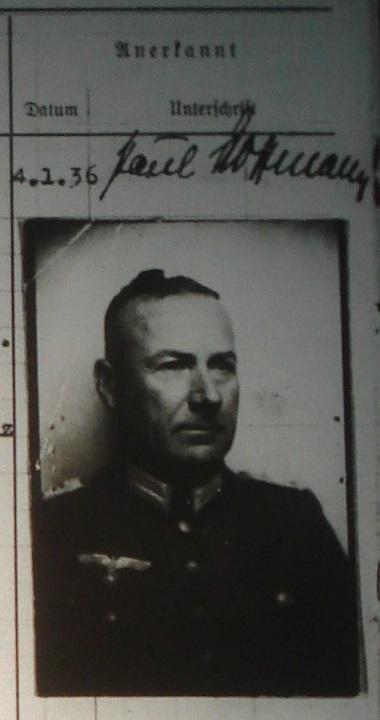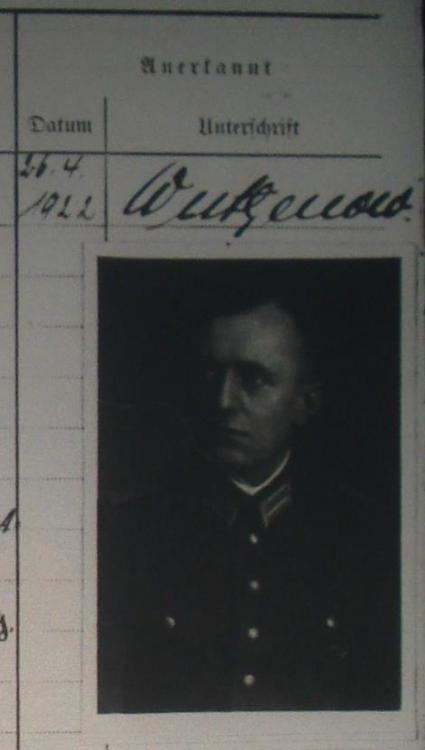-
Posts
4,908 -
Joined
-
Last visited
-
Days Won
97
Content Type
Profiles
Forums
Blogs
Gallery
Events
Store
Everything posted by Dave Danner
-
Thiesenhausen, Anton v. *10.04.1853 in Weißig, †14.07.1935 in Görlitz 18.08.1901 Oberst 18.08.1905 Generalmajor 17.12.1908 Generalleutnant xx.xx.191x General der Infanterie z.D. 07.07.1901 m.d.F.b. d. Infanterie-Regiments Nr. 46 18.08.1901 Kdr. Infanterie-Regiment Nr. 46 22.04.1905 m.d.F.b. d. 17. Infanterie-Brigade 18.08.1905 Kdr. 17. Infanterie-Brigade xx.xx.1908 Kdt. von Straßburg i.E. 10.09.1908 Vorsitzender der Ober-Militär-Prüfungs-Kommission 25.08.1911 zur Disposition gestellt 28.10.1914 Kdr. 97. Reserve-Infanterie-Brigade 12.11.1914 Kdr. 49. Reserve-Division 21.04.1916-05.05.1916 Kdr. 81. Reserve-Division 02.04.1917-02.12.1917 Kdr. 81. Reserve-Division 02.12.1917-18.02.1919 Kdr. 95. Infanterie-Division
-

heer Hoffmann, Paul
Dave Danner replied to hucks216's topic in Germany: All Eras: Signature Database
-

heer Wuthenow, Kurt
Dave Danner replied to hucks216's topic in Germany: All Eras: Signature Database
-
Leibregiment, Leib-Eskadron and Leibkompanie are basically just German translations/adaptations of the French term "Garde du Corps". The closest English equivalent is thus the Life Guards, the senior cavalry regiment of the British Army, although to an American, "Life Guard" is more likely to call to mind David Hasselhoff and Pamela Anderson rather than household cavalry. I agree that a direct translation of the ILR into English makes little sense and does not capture the meaning, although "Infantry Life Guards Regiment" is probably a little better than "Body Regiment" (Wikipedia uses "Royal Bavarian Infantry Lifeguards Regiment"). I would normally not translate the Regiment der Garde du Corps into English either, although I suppose Regiment of Life Guards works for them. They were all basically "Life Guards", whether they kept the French name as in the Regiment der Garde du Corps, used the full term as in the Leibgarde-Infanterie Regiment Nr. 115 or the Leib-Garde-Husaren-Regiment, used just the "Garde" part as in the other Prussian Guards regiments, the Saxon Garde-Reiter-Regiment or the Hessian Garde-Dragoner-Regiment Nr. 23, or used just the "Life" part as in the ILR, the Hessian Leib-Dragoner-Regiment Nr. 24, the Baden Leib-Grenadier-Regiment Nr. 109, etc. Bavaria also had the ceremonial Leibgarde der Hartschiere, which also does not lend itself to a particularly good English translation ("archer" or "archery" life guards sounds pretty awkward to me).
-
LGR 8 was formed on 20 June 1808 and named the "Leib-Regiment" on 26 June. It was renamed 1. Brandenburgisches Infanterie-Regiment on 7 September 1808, but renamed the Leib-Infanterie-Regiment 7 days later. The regiment was one of two formed from the troops who held out against Napoleon's forces in Siege of Colberg (GR 9 was the other). From 1816 to 1846 it was the 8. Infanterie-Regiment (gen. Leib-Regiment) and from 1846 to 1860 the 8. Infanterie-Regiment (gen. Leib-Infanterie-Regiment). It became the Leib-Grenadier-Regiment (with minor variations) in 1860. It was renamed in honor of König Friedrich Wilhelm III on 27 January 1889. So it didn't really "lose" the title, but it went without it for a week in 1808. From 1722 to 1815, the later FR 34 was the Swedish Drottningens livregemente till fot (Leibregiment zu Fuß der Königin). When Swedish Pomerania became part of Prussia, it became a Prussian regiment without the "Leib" name. IR 79 was originally formed in 1866 from companies of IR 27, IR 66 and IR 67 and was garrisoned in Hildesheim. With the annexation of Hannover by Prussia, it became the 3. Hannoversches Infanterie-Regiment Nr. 79. On 24 January 1899, it was assigned the traditions of the Hannoversches Leibregiment. So while IR 79 itself was never a "Leib" regiment, it carried the traditions of an earlier one. On that same date, FR 80 was assigned the traditions of the Kurhessisches Leib-Garde-Regiment. There was a closer connection, since when FR 80 was formed in 1866, it included men from the former Leib-Garde-Regiment in Wiesbaden. Somewhere in the Stammtafel for GR 89, you will find the Schwerinsches Leib-Grenadier-Regiment and Leib-Garde zu Pferde, as well as the Strelitzsches Leibgarde zu Fuß. The 1. Kompanie of GR 89 became the Leibkompanie, but the 5. Kompanie, descended from the Leibgarde zu Fuß, was not designated a Leibkompanie. HR 13 was formed in 1866 from several former Kurhessisch cavalry units (1. Kurhessisches Leib-Husaren-Regiment and the Leib-Eskadron of the Garde du Corps). On 25 August 1887, it was assigned the traditions of the Leib-Husaren-Regiment. Like FR 34, IR 79 and FR 80, in Prussian service, it did not carry the "Leib" name.
-
That is not correct. The sovereign is the one who actually rules the state. No Großherzogin was ever the sovereign of Hessen, since Salic Law kept females out of the line of succession. She was merely the wife or mother of the ruling Großherzog. Regarding IR 117, it was known as Regiment Landgraf from 1790-1806, and its Inhaber was Landgraf Ludwig X. In 1906, Hessen-Darmstadt was elevated to a Grand Duchy, Landgraf Ludwig X became Großherzog Ludwig I, and the regiment was renamed the Leib-Regiment. After Ludwig I died in 1830, Ludwig II was Inhaber until he abdicated in 1848. The regiment was renamed 3. Infanterie-Regiment (Leib-Regiment). There was no Inhaber from 1848-1853. Ludwig III was Inhaber from 1853 until his death in 1877, and Wilhelm Prinz von Hessen was 2. Inhaber from 1867 until his death in 1900. After the Franco-Prussian War, the regiment was normalized in the Prussian numbering system as 3. Großh. Hessisches Infanterie-Regiment (Leib-Regiment) Nr. 117. Großherzogin Victoria Melita, the wife of Großherzog Ernst Ludwig, became Inhaber on 16.6.1897. On 15.2.1902, the regiment was renamed in honor of Victoria Melita as Infanterie-Leibregiment Großherzogin (3. Großh. Hessisches) Nr. 117. So in this case, the designation as a "Leib" regiment was a legacy of its earlier status when the sovereign was the Inhaber. And in case anyone is interested, Hessen-Darmstadt's single cavalry regiment, the Regiment Chevaulegers, became the Garde-Chevaulegers-Regiment in 1806. On 1 January 1860, the regiment was expanded to two regiments and renamed the 1. Reiter-Regiment (Garde-Chevaulegers-Regiment). The new regiment was named the 2. Reiter-Regiment (Leib-Chevaulegers-Regiment). Both regiments were renamed as Dragoner-Regiments on 1 January 1872 when they were standardized in the Prussian system. The Großherzog was Inhaber of both regiments until 1896, when Tsar Nicholas II of Russia became Inhaber of Leib-Dragoner Regiment Nr. 24. Here, too, the regiment retained the "Leib" designation even though the sovereign was no longer the Inhaber, although the Tsar was at least sovereign of another state. Also, all posters are reminded to watch the tone of their posts. This is a gentlemanly forum.
-
The exact date is unknown, as the folder with the recommendation and approval was lost after the war. However, in the index to awards, the folder was Volume 23. Volumes 22 and 24 did survive. Awards in Volume 22 are through late January 1916, and awards in Volume 24 start at 31 January 1916. So Bürkner's award was apparently in the last week of January 1916.
-
Two possible scenarios: 1. The Kriegsverdienstkreuz was established on 8 December 1914. The first awards to IR 55 officers were on 13 December 1914 and the first awards to IR 55 NCOs and men were not until 26 May 1915. Before then, officers received the House Order and NCOs and men received the Militärverdienstmedaille. So there were some who received the LDH or the LMVM first, and never received the LK later. This would not fit with this ribbon bar, though, given the Baden Merit Medal, since he would have to have been an officer at the beginning of the war. 2. The formerly ruling House of Lippe made a number of retroactive awards in the 1920s and 1930s. Since the Ehrenkreuz was a house order, they had the authority to make awards, but the Kriegsverdienstkreuz was a state decoration. The last awards of the Kriegsverdienstkreuz were made in 1920-21, though many were backdated to November 1918. So this could have been a Badener who received the Merit Medal as an NCO, was commissioned a Lt., and was perhaps nominated for the Kriegsverdienstkreuz, but it was not approved in time. So after the war he contacted the former ruling house, and was awarded the Ehrenkreuz instead.
-
Ernst Eugen Heß. Born 8 January 1893 in Wiesbaden, he was living there as a student before the war. He received DLV Flugführerzeugnis Nr. 535 on 26 September 1913. He was killed in action by Fresnes on 23 December 1917 and is buried in the Südfriedhof Wiesbaden. He was single and his father was already deceased, so his possessions likely went to his mother.
-
In the case of Braunschweig, to be awarded the Kriegsverdienstkreuz 1. Klasse, you had to have the EK1. It was not automatic; you still had to be recommended for the award, but the only requirement to approve it was possession of the EK1. It did not require a separate act. The two Mecklenburgs awarded their decorations without regard to what Prussia did. You could receive the Militärverdienstkreuz 1. Klasse or the Kreuz 1. Klasse für Auszeichnung im Kriege whether you had the EK1 or not. Oldenburg was the same way, although Oldenburg also had the habit of awarding both classes of the Friedrich-August-Kreuz at the same time to people who already had the EK1 but had not yet received the OK2. Several recipients of the Kriegsehrenkreuz für heldenmütige Tat from Lippe-Detmold did not have the EK1. Although a pinback, Hessen's Kriegerehrenzeichen in Eisen was comparable to the Bewährungsabzeichen for Braunschweig's Kriegsverdienstkreuz 2. Klasse. You had to be from the state and have spent an extended period at the front lines and been wounded ("Ich will es hessischen Staatsangehörigen, die sich bei andauernder Betätigung in vorderster Kampflinie durch Tapferkeit ausgezeichnet und ihr Blut vergossen haben, auf Vorschlag ihrer Vorgesetzten und auf Grund besonders ergehender Bestimmungen verleihen."). The other awards were much rarer. Schaumburg-Lippe's was the rarest, since only 20 were awarded and 18 of those were to Fürstlichkeiten (and 11 of those were princes of Schaumburg-Lippe). Regarding people with more than one pinback besides the EK1, I would say the most common were Mecklenburgers with both the Schwerin and Strelitz pinbacks, and navy officers with the Mecklenburg-Schwerin and Oldenburg crosses. There were also probably a few X. Armeekorps officers with both the Braunschweig and Oldenburg crosses. I know of a small handful of IR 94 and IR 96 officers with both the Reuß and Sachsen-Weimar pinbacks and at least one IR 95 officer with Sachsen-Weimar and Sachsen-Coburg u. Gotha. The Kaiser had most, but not all (notably, not Schaumburg-Lippe's pinback, even though Kaiser Karl, Tsar Ferdinand and Sultan Mehmet V had it). Crown Prince Rupprecht had three (Lippe-Detmold and both Mecklenburgs). Hindenburg received at least six (Braunschweig, Lippe-Detmold, both Mecklenburgs, Reuß and Sachsen-Coburg u. Gotha) and probably also Oldenburg. Ludendorff had at least five (Lippe-Detmold, both Mecklenburgs, Reuß and Sachsen-Coburg u. Gotha) and probably also Oldenburg and Braunschweig.
-
Here is an example of someone named an Offizier-Aspirant while still a Gefreiter, which seems odd. Personnel files often omit this Ernennung, and only list Beförderungen. Here is one with the Ernennung at the same time as the promotion to Unteroffizier: Another as an Unteroffizier, although only two weeks before promotion to Vizewachtmeister: Vizewachtmeister and Offizier-Aspirant at the same time:
-
That's Harry. 29.06.35 Maj. (E) (RDA 01.06.34) 01.04.39 Oberstlt. 01.07.42 Oberst Other than two months (1.4.42-31.5.42) at the Heeresremonteamt Neu-Poserin, he remained at Breithülen throughout the war. Harry and Artur were brothers. Harry also had the BMV4X and MMV1, but no HOH3X or HH, nor the prewar awards, and as an E-Offizier received the Wehrmacht Dienstauszeichnung.
-
It is possibly Artur August Anton Johannes Albert Sophus v. Müller from the 2.GUR. He had a prewar KO4 and received the MG3 from Mecklenburg-Strelitz on 21.7.1914, so after the publication of the 1914 rank list. He was promoted to Rittmeister on 8.11.1914 and served with DR 18 and as a Bataillons-Führer in an infantry regiment during the war. He received both the MMV1 and the BMV4X. He is not confirmed to have received the HOH3X. However, a Rittmeister v. Müller who was not Ludo from UR 5 or Harry from DR 7 was gazetted with the HOH3X in July 1918. I'm not sure if there were any other Rittmeisters v. Müller in 1918. He was born on 23.8.1882 in Groß Lunow, Mecklenburg-Schwerin, and was killed there by the Soviets on 6.6.1945. The Ehrenrangliste shows him as a Rittmeister a.D., while the 2006 edition of Gotha lists him as an Oberst a.D. I have not found him in any active Heer or Luftwaffe sources, so I assume he was a reserve officer or the like.
-
More on the later Oberst Luitpold Steidle: • https://en.wikipedia.org/wiki/Luitpold_Steidle • https://www.ancestry.com/family-tree/person/tree/54097702/person/402065078985/facts Luitpold Steidle's Friedenstruppenteil was the Kriegsschule in München, so presumably his personal effects remained there when he was in the field and later taken prisoner in Stalingrad. Since he never returned to West Germany, he was possibly never reunited with them. Their father was also a Bavarian Army officer. Dr.jur. Eduard Steidle served as an Oberkriegsgerichtsrat with Etappen-Inspektion Nr. 6 and was promoted to Maj.d.L. in 1916. The navy officer Wolfgang was their first cousin, along with Wolfgang's brother Hans, who was a Feldunterarzt. Both were Luftwaffe officers, Hans as an Oberstarzt and Wolfgang as a Hauptmann d.R.z.V. in Seenotdienst.
-
The only other Leutnant I found was Lt.d.R. Robert Steidle, brother of Luitpold from the ILR. There were also several medical officers. There was also a naval officer, Lt.z.S. Wolfgang Steidle, whose wife was a distant relative of mine. BTW, I don't know if you knew this, if you have a common name and want to narrow your searches in Ancestry to officers, you can put "Kriegsrangliste" under keywords and click exact match to remove all the Stammrollen from your results.
-
According to a file in the archives in Wolfenbüttel which I reviewed several years ago, 113 officers in HR 3 received the Kriegsverdienstkreuz. Only two were turned down, because they were in the Ersatz-Eskadron and not in the field with the regiment. Gropius is not in the list, so I doubt he was with HR 3 itself. However, he was with RHR 9 when he was promoted to Leutnant der Landwehr in November 1914. RHR 9 was raised by HR 3, so maybe he was among the first EK recipients in that regiment.
-
This is probably a dumb question, but this is a lieutenant's uniform, isn't it? The Wikipedia caption is "Gropius in his sergeant's uniform during World War I". The section of the article itself on his service appears to have been written by someone unfamiliar with the German armed forces. It says Gropius "was drafted August 1914 and served as a sergeant major at the Western front during the war years (getting wounded and almost killed) and then as a lieutenant in the signal corps". Gropius was not drafted, but rather was called up as a reservist. He started the war as a Vizewachtmeister der Reserve in Reserve-Husaren-Regiment Nr. 9, and was promoted to Leutnant der Landwehr-Kavallerie I on 1.11.1914. The "signal corps" part is not completely wrong - he was a cavalry officer, but he did serve at the Heeresnachrichtenschule Namur. The article also says Gropius "was awarded the Iron Cross twice". That should really be he "was awarded both classes of the Iron Cross" (he was, although obviously the 1st Class came after the photo was taken). For what it's worth, he also received the Bavarian Militär-Verdienstorden 4.Klasse mit Schwertern and the Austro-Hungarian Militärverdienstkreuz 3.Klasse mit der Kriegsdekoration 3.Klasse. The German Wikipedia article is worse, as it identifies him incorrectly as an Unteroffizier der Reserve and mentions that he was wounded and received the Iron Cross.





